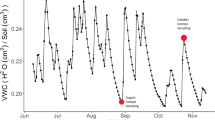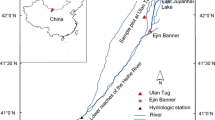Abstract
Hydraulic lift (HL) by tree roots in a young, broad-leaved, mixed temperate European forest was investigated during the 2008 growing season by injecting 18O-enriched soil water at a depth of 75–90 cm under drought conditions experimentally imposed in a rain-exclusion system. Based on sap flow, leaf water potential, 2-D root distribution measurements, soil isotope profiles, and xylem water isotope composition, water acquisition and use by two tree species, beech (Fagus sylvatica) and oak (Quercus petraea) was compared. We showed that, unlike oak, beech experienced a marked decrease in sap flow and predawn leaf water potential with increasing soil drought. This behaviour was logical considering the shallower root system in beech than in oak. Six days after 18O-labelling, we observed isotopic enrichment in the shallower soil layers. Since the intermediate soil layers did not display any enrichment, our results clearly pointed to hydraulic lift by tree roots. The superficial enrichment that was observed in the vicinity of oak trunks and the increase in the isotopic signature of xylem sap in the oak trees but not in the beech trees confirmed the predominant role of oak in the hydraulic lift at our site. Even though facilitation for water acquisition among species was not observed here, our results suggest a potential positive contribution of species like oak toward maintaining species diversity in mixed forest ecosystems submitted to severe drought events.






Similar content being viewed by others
References
Allen M (2007) Mycorrhyzal fungi: highways for water and nutrients in arid soils. Vadoze Zone J 6(2):291–297
Aranda I, Gil L, Pardos JA (1996) Seasonal water relations of three broadleaved species (Fagus sylvatica L., Quercus petraea (Mattuschka) Liebl and Quercus pyrenaica Willd) in a mixed stand in the centre of the Iberian Peninsula. For Ecol Manag 84:1–3
Aranda I, Gil L, Pardos JA (2005) Seasonal changes in apparent hydraulic conductance and their implications for water use of European beech (Fagus sylvatica L.) and sessile oak [Quercus petraea (Matt.) Liebl] in South Europe. Plant Ecol 179:155–167
Barataud F, Moyne C, Bréda N, Granier A (1995) Soil water dynamics in an oak stand: II. A model of the soil-root network compared with experimental data. Plant Soil 172:29–43
Bauerle T, Richards J, Smartt D, Eissenstat D (2008) Importance of internal hydraulic redistribution for prolonging the lifespan of roots in dry soil. Plant Cell Environ 31:177–186
Bonal D, Atger C, Barigah TS, Ferhi A, Guehl JM, Ferry B (2000) Water acquisition patterns of two wet tropical canopy trees of French Guiana as inferred from H 182 O extraction profiles. Ann For Sci 57:717–724
Bouriaud O, Bréda N, Le Moguedec G, Nepveu G (2004) Modelling variability of wood density in beech as affected by ring age, radial growth and climate. Trees 18:264–276
Breazeale J (1930) Maintenance of moisture-equilibrium and nutrition of plants at and below the wilting percentage. Ariz Agric Exp Stn Tech Bull 29:137–177
Bréda N, Granier A, Barataud F, Moyne C (1995) Soil water dynamics in oak stand. I. Soil moisture, water potentials, and water uptake by roots. Plant Soil 172:17–27
Brooks JR, Meinzer FC, Warren JM, Domec JC, Coulombe R (2006) Hydraulic redistribution in a Douglas-fir forest: lessons from system manipulations. Plant Cell Environ 29:138–150
Buée M, Vairelles D, Garbaye J (2005) Year-round monitoring of diversity and potential metabolic activity of the ectomycorrhizal community in a beech (Fagus sylvatica) forest subjected to two thinning regimes. Mycorrhiza 15:235–245
Caldwell M, Richards J (1989) Hydraulic lift: water efflux from upper roots improves effectiveness of water uptake by deep roots. Oecologia 79:1–5
Caldwell M, Dawson T, Richards J (1998) Hydraulic lift: consequences of water efflux from the roots of plants. Oecologia 113:151–161
Courty PE, Franc A, Pierrrat JC, Garbaye J (2008) Temporal changes in the ectomycorrhizal community in two soil horizons of a temperate oak forest. Appl Environ Microbiol 74(18):2792–2801
Dawson T (1993) Hydraulic lift and water use by plants: implications for water balance, performance and plant-plant interactions. Oecologia 95:565–574
Dawson T (1996) Determining water use by trees and forests from isotopic, energy balance and transpiration analyses: the role of the size and hydraulic lift. Tree Physiol 16:263–272
Domec J, Warren J, Meinzer F, Brooks J, Coulombe R (2004) Native root xylem embolism and stomatal closure in stands of douglas-fir and ponderosa pine: mitigation by hydraulic redistribution. Oecologia 141:7–16
Egerton-Warburton LM, Querejeta JI, Allen MF (2007) Common mycrorrhizal networks provide a potential pathway for the transfer of hydraulically lifted water between plants. J Exp Bot 58(6):1473–1483
Espeleta JF, West JB, Donovan LA (2004) Species-specific patterns of hydraulic lift in co-occurring adult trees and grasses in a sandhill community. Oecologia 138:341–349
Granier A (1985) Une nouvelle méthode pour la mesure de flux de sève brute dans le tronc des arbres. Ann For Sci 42:193–200
Granier A (1987) Evaluation of transpiration in a Douglas-fir stand by means of sap flux measurements. Tree Physiol 3:309–320
Granier A, Biron P, Lemoine D (2000) Water balance, transpiration and canopy conductance in two beech stands. Agric For Meteorol 100:291–308
Granier A, Bréda N, Longdoz B, Gross P, Ngao J (2008) Ten years of fluxes and stand growth in a young beech forest at Hesse, North-eastern France. Ann For Sci 65:704–715
Hodgson JM (1978) Soil sampling and soil description. Oxford University Press, Oxford
Holscher D, Koch O, Korn S, Leuschner C (2005) Sap flux of five co-occurring tree species in a temperate broad-leaved forest during seasonal soil drought. Trees Struct Func 19(6):1–18
Jackson RB, Moore LA, Hoffmann WA, Pockman WT, Linder CR (1999) Ecosystem rooting depth determined with caves and DNA. Proc Natl Acad Sci USA 96:11387–11392
Jackson R, Sperry J, Dawson T (2000) Root water uptake and transport: using physiological processes in global predictions. Trends Plant Sci 5(11):1360–1385
Kramer P (1983) Root growth and functions. In: Water relations of plants. Academic Press, Inc., San Diego, pp 120–145
Kurz-Besson C, Otieno D, do Vale RL, Siegwolf R, Schmidt M, Herd A, Nogueira C, David TS, David JS, Tenhunen J, Pereira JS, Chaves M (2006) Hydraulic lift in cork oak trees in a savannah-type Mediterranean ecosystem and its contribution to the local water balance. Plant Soil 282:361–378
Lebourgeois F, Bréda N, Ulrich E, Granier A (1995) Climate-tree-growth relationships of European beech (Fagus sylvatica L.) in the French Permanent Plot Network (RENECOFOR). Trees 19:385–401
Leuschner C, Backes K, Hertel D, Schipka F, Schmitt U, Terborg O, Runge M (2001) Drought responses at leaf, stem and fine root levels of competitive Fagus sylvatica L. and Quercus petraea (Matt.) Liebl. trees in dry and wet years. For Ecol Manag 149:33–46
Leuzinger S, Zotz G, Asshoff R, Korner C (2005) Responses of deciduous forest trees to severe drought in central Europe. Tree Physiol 25:641–650
Lilleskov EA, Burns TD, Dawson TE, Comacho FJ (2009) Water sources and controls on water-loss rates of epigeous ectomycorrhizal fungal sporocarps during summer drought. New Phytol 182:483–494
Magistad O, Breazeale J (1929) Plant and soil relations at and below the wilting percentage. Ariz Agric Exp Stn Tech Bull 25:1–36
Meinzer F, Warren J, Brooks J (2007) Species-specific partitioning of soil water resources in an old-growth Douglas-fir-western hemlock forest. Tree Physiol 27:871–880
Milikin-Ishikawa M, Bledsoe C (2000) Seasonal and diurnal patterns of soil water potential in the rhizosphere of blue oaks: evidence for hydraulic lift. Oecologia 125:459–465
Moreira MZ, Scholz FG, Bucci SJ, Sternberg LS, Goldstein G, Meinzer FC, Franco AC (2003) Hydraulic lift in a neotropical Savanna. Funct Ecol 17:573–581
Nadezhdina N, Ferreira M, Silva R, Pacheco C (2008) Seasonal variation of water uptake of a Quercus suber tree in central Portugal. Plant Soil 305:105–119
Peñuelas J, Fillela I (2003) Deuterium labelling of roots provides evidence of deep water access and hydraulic lift by Pinus nigra in a Mediterranean forest of NE Spain. Environ Exp Bot 49:201–208
Querejeta JI, Egerton-Warburton LM, Allen MF (2003) Direct nocturnal water transfer from oaks to their mycorrhizal symbionts during severe soil drying. Oecologia 134:55–64
Querejeta J, Egerton-Warburton L, Allen M (2007) Hydraulic lift may buffer rhizosphere hyphae against the negative effects of severe soil drying in a California oak Savanna. Soil Biol Biochem 39:409–417
Simard S, Perry DA, Jones MD, Myrold D, Durall D, Molinak R (1997) Net transfer of carbon between ectomycorrhizal tree species in the field. Nature 388:579–582
Snyder K, James J, Richards J, Donovan L (2008) Does hydraulic lift or nighttime transpiration facilitate nitrogen acquisition? Plant Soil 306:159–166
Thomas FM, Hartmann G (1998) Tree rooting patterns and soil water relations of healthy and damaged stands of mature oak (Quercus robur L and Quercus petraea [Matt] Liebl). Plant Soil 203:145–158
Van der Werf GW, Sass-Klaassen UGW, Mohren GMJ (2007) The impact of the 2003 summer drought on the intra-annual growth pattern of beech (Fagus sylvatica L.) and oak (Quercus robur L.) on a dry site in the Netherlands. Dendrochronologia 25:103–112
Van Noordwijk M, Brouwer G, Meijboom F, do Rosário G, Oliveira M, Bengough A (2000) Trench profile techniques and core break methods. In: Smit A, Bengough A, Engels C, van Noordwiijk M, Pelleri S, van de Geijn S (eds) Root methods a handbook. Springer, Berlin, pp 211–233
Van Wijk (1963) Physics of plant environment. In: Van Wijk (ed) North-Holland publishing company, Amsterdam
Warren J, Meinzer F, Brooks J, Domec J (2005) Vertical stratification of soil water storage and release dynamics in Pacific Northwest coniferous forests. Agric For Meteorol 130:39–58
West AG, Patrickson SJ, Ehleringer JR (2006) Water extraction times for plant and soil materials used in stable isotope analysis. Rapid Commun Mass Spectrom 20:1317–1321
White JWC, Cook ER, Lawrence JR, Broeckler WS (1985) The D/H ratios of sap in trees: implication for water sources and tree ring D/H ratios. Geochim Cosmochim Acta 49:237–246
WRB (2006) World reference base for soil resources 2006. A framework for international classification, correlation and communication. In: World soil resources reports 103, Food and Agriculture Organization of the United Nations, Rome, 2006
Zapater M (2009) Functional diversity of water use in a young broad leaved mixed forest: ecophysiological and isotopic approaches. PhD thesis, University of Nancy, France
Acknowledgments
We are very grateful to Bernt Zeller and Oliver Brendel for intense discussions on isotopes before this experimentation. We are also grateful to Pascal Courtois, Bernard Clerc, Jean-Marie Gioria, Patrick Gross and Sylvia Pardonnet for their technical support in the field. The financial support of this research was provided by the French programme “Ecoger”. Marion Zapater was supported by a Doctoral Fellowship from the French Ministry of Research.
Author information
Authors and Affiliations
Corresponding author
Additional information
Communicated by A. Gessler.
Rights and permissions
About this article
Cite this article
Zapater, M., Hossann, C., Bréda, N. et al. Evidence of hydraulic lift in a young beech and oak mixed forest using 18O soil water labelling. Trees 25, 885–894 (2011). https://doi.org/10.1007/s00468-011-0563-9
Received:
Revised:
Accepted:
Published:
Issue Date:
DOI: https://doi.org/10.1007/s00468-011-0563-9




